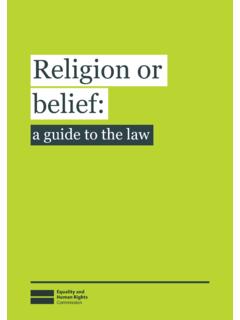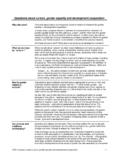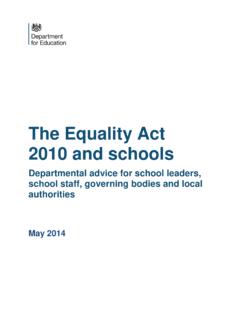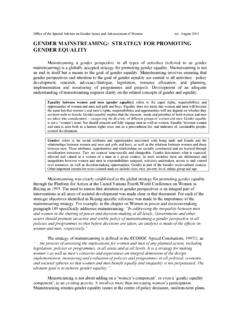Transcription of FAO Policy on Gender Equality 2020 2030
1 AFAO Policy ON Gender Equality | 2020 2030 FAO Policy ON Gender EQUALITY2020 2030 FAO Policy ON Gender Equality 2020 2030 Food and Agriculture Organization of the United Nations Rome, 2020 FAO. 2020. FAO Policy on Gender Equality 2020 2030. designations employed and the presentation of material in this information product do not imply the expression of any opinion whatsoever on the part of the Food and Agriculture Organization of the United Nations (FAO) concerning the legal or development status of any country, territory, city or area or of its authorities, or concerning the delimitation of its frontiers or boundaries. The mention of specific companies or products of manufacturers, whether or not these have been patented, does not imply that these have been endorsed or recommended by FAO in preference to others of a similar nature that are not mentioned. FAO, 2020 Some rights reserved. This work is made available under the Creative Commons Attribution-NonCommercial-ShareAlike IGO licence (CC BY-NC-SA IGO; ).
2 Under the terms of this licence, this work may be copied, redistributed and adapted for non-commercial purposes, provided that the work is appropriately cited. In any use of this work, there should be no suggestion that FAO endorses any specific organization, products or services. The use of the FAO logo is not permitted. If the work is adapted, then it must be licensed under the same or equivalent Creative Commons licence. If a translation of this work is created, it must include the following disclaimer along with the required citation: This translation was not created by the Food and Agriculture Organization of the United Nations (FAO). FAO is not responsible for the content or accuracy of this translation. The original [Language] edition shall be the authoritative edition. Disputes arising under the licence that cannot be settled amicably will be resolved by mediation and arbitration as described in Article 8 of the licence except as other-wise provided herein.
3 The applicable mediation rules will be the mediation rules of the World Intellectual Property Organization and any arbitration will be conducted in accordance with the Arbitration Rules of the United Nations Commission on International Trade Law (UNCITRAL).Third-party materials. Users wishing to reuse material from this work that is attributed to a third party, such as tables, figures or images, are responsible for determining whether permission is needed for that reuse and for obtaining permission from the copyright holder. The risk of claims resulting from infringement of any third-party-owned component in the work rests solely with the , rights and licensing. FAO information products are available on the FAO website ( ) and can be purchased through Requests for commercial use should be submitted via: Queries regarding rights and licensing should be submitted to: ivACRONYMS viINTRODUCTION 1 RATIONALE 3 FAO S Gender Equality GOAL AND OBJECTIVES 5 STRATEGY AND APPROACHES 11 MINIMUM STANDARDS FOR Gender MAINSTREAMING 12 THEORY OF CHANGE 15 ACCOUNTABILITY FRAMEWORK 16ivFOREWORDI am honored to present the updated FAO Policy on Gender Equality , which will drive the Organization s work on Gender Equality and women s empowerment over the next decade.
4 Personally and as Director- General, I firmly stand behind the key message conveyed by this Policy : Achieving Gender Equality in agriculture is critical to eradicating hunger, malnutrition and poverty. The launching of this Policy is very timely. The year 2020 is a pivotal year for advancing Gender Equality worldwide, as the global community takes stock of progress made for women s rights since the adoption of the Beijing Platform for Action in 1995. It will also mark the five-year milestone towards achieving the Agenda 2030 and its Sustainable Development Goals. For FAO, the year 2020 is of special relevance when it comes to Gender issues, as it is the first year of FAO s first ever Women Committee being fully active. The FAO Women Committee, which was established on the occasion of the International day of Rural Women, 15 October 2019, provides an inclusive, safe space that reflects the diverse and energetic nature of FAO s female workforce. The volunteer-based committee consists of an impressive and wide array of FAO women from the agency s Rome headquarters, as well as representatives from its regional, liaison and country offices across the globe.
5 The Committee aims to empower female employees, providing assistance through learning and extending its reach by fostering friendships. The Committee is inclusive, enabling everyone to engage in promoting women s political, economic, cultural and biological rights. At the same time, the Committee is a platform for dialogue with FAO Members on women s issues. FAO s vision is to highlight women s vital contribution throughout the political, economic, cultural and family dimensions of agricultural and rural development. The Organization is committed to work closely with its Members in focusing on issues affecting women s rights as well as providing support and expertise in enhancing their contribution to rural and agricultural development. vThe FAO Women Committee works in close collaboration with the other newly established FAO Committee, namely the Youth Committee in instilling a new positive, dynamic and inclusive dimension into the Organization s daily year 2020 is also an opportunity to take stock of achievements and persisting gaps, and to step up our commitment to promoting equitable food systems.
6 Food systems that are capable of providing sustainable livelihoods and healthy diets for all men, women, boys and girls, while protecting the resource base for future generations. The transformation of food systems that we are all striving for, can only be achieved by prioritizing the social dimension and by adopting pro-poor, Gender -transformative approaches that ensure equal opportunities for all. Special attention should be placed to overcoming the persistent Gender inequalities that undermine rural women s potential and increase their vulnerability to the social, economic and environmental challenges facing the agricultural sector. The Policy provides FAO with a vision and a shared framework of accountability for our work, collectively and individually, towards this goal. Building on lessons learned, the Policy underlines that, in order to advance on the ambitious objectives it sets, FAO needs to go beyond business as usual . We need to tackle the root causes of Gender inequalities with boldness and determination.
7 The Policy urges all of us to see women and men as equal partners, not only in our work with Member States, but also within our own Organization. A successful implementation of the Policy means embracing innovation, fostering partnerships, leveraging impact, and enhancing the efficiency and effectiveness of FAO s modus operandi. Our Organization is well aware that investing in rural women by enhancing their capacities, decision-making power and access to key resources, services and opportunities, is a winning strategy to accelerate progress towards rural development and food security. A Gender -equal world is the only way to achieve a world free from hunger and malnutrition. We all have a part to play and a lot to gain in making this Dongyu Director-GeneralviACRONYMSADG Assistant Director-General BPfA Beijing Platform for ActionCEDAW Convention on the Elimination of All Forms of Discrimination Against Women CSH Human Resources DivisionDDG Deputy Director-GeneralDG Director-General ESA Agrifood Economics Division ESS Statistics Division ESP Inclusive Rural Transformations and Gender Equity Division FAO Food and Agriculture Organization of the United Nations FAOR FAO RepresentativeHR Human Resources OCC Office of Communications OCS Office of Chief StatisticianOED Office of Evaluation OIG Office of the Inspector-General OSG Office of SDGsOSP Office of Strategy.
8 Planning and Resources Management PSR Resource Mobilization and Private Sector Partnerships DivisionPSS Project Support DivisionPST South-South and Triangular Cooperation DivisionRM Resource MobilizationSDGs Sustainable Development GoalsSOFA State of Food and Agriculture Report UN-SWAP UN System-Wide Action Plan on Gender Equality and the Empowerment of Women TCP Technical Cooperation Programme 1 FAO Policy ON Gender Equality | 2020 2030 INTRODUCTIONG ender Equality is essential to achieve FAO s mandate of a world free from hunger, malnutrition and poverty. The Organization recognizes that persisting inequalities between women and men are a major obstacle to agriculture and rural devel-opment and that eliminating these disparities is essential to building sustainable and inclusive food systems and resilient and peaceful remarkable progress has been made in advancing Gender Equality , significant gaps remain to be addressed. As stated by the UN Secretary-General in his message on International Women s Day 2018, achieving Gender Equality and empow-ering women and girls is the unfinished business of our time, and the greatest human rights challenge in our world.
9 FAO s commitment to promote Gender Equality stems from the intergovernmental mandate of the United Nations to promote and protect women s rights as fundamental human rights, as recognized by the 1948 Universal Declaration of Human Rights and the 1979 Convention on the Elimination of All Forms of Discrimination against Women (CEDAW). The Convention is extremely relevant to FAO s mandate as Article 14 draws attention to the unique situation and needs of rural women, and binds States parties to take all appropriate measures to eliminate any form of discrimination that prevent them from benefiting equally from rural develop-ment. FAO s efforts towards Gender Equality are also guided by the commitments agreed upon in the Beijing Declaration and Platform for Action (BPfA), which 25 years after its adoption remains the most progressive and ambitious blueprint for the empowerment of women and 2015, FAO has aligned its work to the 2030 Agenda for Sustainable Development, which provides the international community with a comprehensive framework to tackle global challenges, aiming to eradicate poverty, hunger and malnutrition, reduce multiple and intersecting inequalities, address climate change and sustain peace.
10 Building on the norms and commitments contained in the CEDAW and the BPfA, Gender Equality is very prominent throughout the 2030 Agenda, both in the form of a stand-alone goal (Goal 5) and as a cross-cutting theme, with more than 30 Gender -related targets across the other SDGs. The fundamental pledge to leave no one behind , which is at the heart of the implemen-tation of the SDGs, urges all partners, including FAO, to address the underlying causes of Gender inequality and to work in a way that ensures equal opportunities through integrated and transformative to the relentless efforts of women s rights advocates from across the world, Gender Equality is increasingly recognized as a building block towards sustainable development in a wide range of global agreements and conventions that guide FAO s work on agriculture, natural resources management and rural development for food security and nutrition. These include the United Nations Convention to Combat Desertification, recently complemented by a Gender Action Plan, and the 2016 Paris Agreement, adopted at the Conference of the Parties of the UN Framework Convention on Climate Change.
















